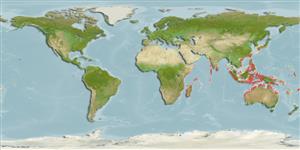Actinopterygii (ray-finned fishes) >
Perciformes (Perch-likes) >
Blenniidae (Combtooth blennies) > Salariinae
Etymology: Mimoblennius: Greek, mimos =mime + Greek, blennios = mucus (Ref. 45335).
Environment / Climate / Range
Ecology
Marine; reef-associated; depth range 2 - 10 m (Ref. 30874). Tropical, preferred ?
Eastern Indian Ocean and Western Pacific: Sri Lanka and Christmas Island in the Indian Ocean, southern Japan and Hong Kong.
Size / Weight / Age
Maturity: Lm ? range ? - ? cm
Max length : 5.0 cm TL male/unsexed; (Ref. 30874)
A rare species (Ref. 559). Adults live in abandoned worm tubes, solitary or in loose groups (Ref. 90102). Oviparous. Eggs are demersal and adhesive (Ref. 205), and are attached to the substrate via a filamentous, adhesive pad or pedestal (Ref. 94114). Larvae are planktonic, often found in shallow, coastal waters (Ref. 94114).
Life cycle and mating behavior
Maturity | Reproduction | Spawning | Eggs | Fecundity | Larvae
Oviparous, distinct pairing (Ref. 205).
Masuda, H., K. Amaoka, C. Araga, T. Uyeno and T. Yoshino, 1984. The fishes of the Japanese Archipelago. Vol. 1. Tokai University Press, Tokyo, Japan. 437 p. (text). (Ref. 559)
IUCN Red List Status (Ref. 115185)
CITES (Ref. 94142)
Not Evaluated
Threat to humans
Harmless
Human uses
More information
ReferencesAquacultureAquaculture profileStrainsGeneticsAllele frequenciesHeritabilityDiseasesProcessingMass conversion
Tools
Special reports
Download XML
Internet sources
